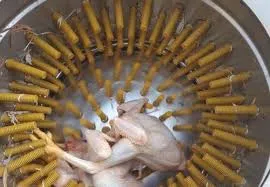Best Chicken Scalder - Efficient and Reliable Poultry Processing Solutions
កញ្ញា . 01, 2024 16:49 Back to list
Best Chicken Scalder - Efficient and Reliable Poultry Processing Solutions
The Best Chicken Scalder Ensuring Efficiency and Quality in Poultry Processing
In the poultry processing industry, one essential step that often goes unnoticed but plays a crucial role is scalding. This process involves submerging chickens in hot water to loosen feathers for easier plucking. Choosing the best chicken scalder is vital for maximizing efficiency while ensuring high-quality meat products. In this article, we explore the critical features to consider when selecting a chicken scalder and how it can impact the overall processing operation.
One of the most important factors to assess is the scalder's temperature control. An optimal scalding temperature is typically between 140°F to 160°F (60°C to 71°C), depending on the desired plucking efficiency and feather condition. A high-quality scalder should provide precise temperature regulation to prevent over-scalding, which can lead to skin damage and adversely affect the meat quality. Regularly monitoring the temperature ensures feathers are loosened effectively without compromising the integrity of the chicken's skin.
Capacity is another crucial element that should not be overlooked. The best chicken scalder must accommodate the processing volume required by a poultry operation, whether it’s a small farm or a large-scale commercial plant. Scalder designs vary from batch systems to continuous flow systems; hence, understanding your processing needs will guide you in selecting a scalder that maximizes throughput while maintaining quality.
best chicken scalder

Moreover, materials used in the construction of the scalder are essential for longevity and hygiene. Stainless steel is the preferred material due to its resistance to corrosion, ease of cleaning, and durability. A high-quality scalder made from stainless steel not only meets hygiene standards but also withstands the rigors of continuous use, leading to lower maintenance costs in the long run.
Another significant aspect to consider is the scalder’s water management system. Efficient water usage is essential for reducing operational costs and minimizing environmental impact. Look for models that incorporate effective water recycling and filtration systems, which can help to keep the water clean while reducing the amount of freshwater needed. This not only ensures a more sustainable operation but also contributes to better meat quality by preventing contamination.
Finally, user-friendliness and maintenance demand are factors that can greatly influence operational efficiency. The best chicken scalder should be designed for easy operation with clear controls and minimal training required for the staff. Additionally, consider scalders that are easy to clean and maintain to minimize downtime during operations.
In conclusion, selecting the best chicken scalder is a critical decision in the poultry processing industry. With a keen focus on temperature control, capacity, material quality, water management, and operational efficiency, processors can ensure optimal results. Investing in a top-of-the-line scalder not only enhances the quality of the finished product but also contributes to a streamlined, efficient processing operation, ultimately benefiting both producers and consumers in the competitive market.
-
Automatic Feeding Line System - Anping County Yize Metal Products Co., Ltd.|Pan Feeder&Nipple Drinker
NewsAug.06,2025
-
Automatic Feeding Line System - Yize Metal|Automation,Durability,Precision
NewsAug.06,2025
-
Automatic Feeding Line System Pan Feeder Nipple Drinker - Anping County Yize Metal Products Co., Ltd.
NewsAug.06,2025
-
Feed Pellet Machine | High-Quality Animal Feed Pelletizer
NewsAug.06,2025
-
Automatic Feeding System - Anping Yize | Pan Feeder Nipple Drinker
NewsAug.05,2025
-
Automatic Feeding Line System Pan Feeder Nipple Drinker-Anping County Yize Metal Products Co., Ltd.|Feed and Water Distribution, Durable PP Material
NewsAug.05,2025






